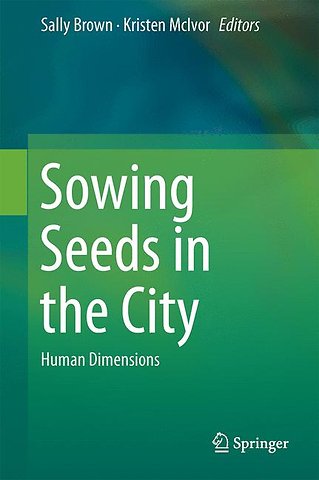Sowing Seeds in the City
Human Dimensions
Gebonden Engels 2016 9789401774543Samenvatting
A majority of the world’s population lives in cities. Urban areas have largely been disconnected from the processes associated with producing food. A broad range of community efforts have emerged to reconnect people in urban areas to fresh foods with expected benefits for public health. These efforts can be found in cities across the country and cross both economic and ethnic lines. They have been led by the non- scientific community and are best characterized as social movements. Expansion of agriculture to non- traditional areas including community or kitchen gardens in urban or peri- urban environments has the potential to provide a range of ecosystem services as well as reduce stressors on non- urban environments. These services/benefits include improved public health, improved human nutrition and diet, large-scale production of renewable resources, increased food security with less resilience on traditional agricultural landscapes and seascapes, enhanced ecosystem function in urban areas, and increased public appreciation for and understanding of ecosystem services.
Specificaties
Lezersrecensies
Inhoudsopgave
<p> </p>
<p> </p>
<p> </p>
<p> </p>
<p>Preface<br> Chapter 1, Introduction: Faces of Agriculture; Bill Yosses <br> Part I: Perspectives on Food Security and the Impacts of Urban Agriculture<br> Chapter 2. Food Security and Urban Agriculture; Angie Tagtow<br> Chapter 3. Urban Agriculture as a Resiliency Strategy; Steve Hallett<br> Chapter 4. The Long Tradition of Urban Agriculture in the U.S. – and its Future; Ken Meter<br> Part II: Individual and Community Health Benefits of Urban Agriculture<br> Chapter 5. Harvesting Health in the Garden; Katherine Alaimo, Caroline Crawford, and Liz Snyder<br> Chapter 6. Social Health and Social Capital; Caroline Crawford and Katherine Alaimo<br> Chapter 7. Urban Gardening Practices and Culture; Nancy Nix<br> Chapter 8. Nature Contact, Health, and the Built Environment; Jerry Smith<br> Chapter 9. A Case Study: The Discourse of Obesity and Public Health in Planning and Participation in New York City Gardens; Yolanda Gonzalez, Matthew Potteigger, Anne Bellows, Evan Weissman, and Carolin Mees <br> Part III: Managing the Risks of Urban Agriculture<br> Chapter 10. Assessing and Communicating the Risks (and Benefits) of Community Participation in Urban Agriculture; John F. Obrycki and Liz Snyder<br> Chapter 11. Modeling to Predict High Pb Areas; Kirsten Schwarz<br> Chapter 12. Screening for Soil Lead Using a Common Soil Test Method; John Obrycki, Kristen K. Minca, Nicholas T. Basta<br> Chapter 13. Mechanisms to Reduce Risk Potential; Ganga M. Hettiarachchi, Chammi P. Attanayake, Philip P. Defoe, and Sabine E. Martin<br> Chapter 14. A Case Study: Potential Health Risks Posed by Eating Eggs from Free Range Chickens in New York City; Henry M. Spliethoff<br> Part IV: Democracy, Ethics, and Sovereignty in Urban Agriculture<br> Chapter 15. Common Roots: Urban Agriculture’s Potential for Cultivating Deep Democracy; David W. McIvor and James Hale<br> Chapter 16. Ethics of Urban Agriculture; Gavin Van Horn<br> Chapter 17. A Case Study of Spatial and Economic Sovereignty: Reclaiming Space and Building Community in Philadelphia One Vacant Lot at a Time; Brandon Hoover<br> Part V: Research on Urban Agriculture and Food Security<br> Chapter 18. Case Studies of Urban Food Security Research: A Focus on Methodology; Shannon Donovan, Liz Snyder, Renata Ballesteros-Lopez, Liza Root, Shaina Seidner, and Carol McCarty<br> Chapter 19. A Case Study: Native Perspectives of Gardening; Megan Bang<br> Chapter 20. A Case Study on Learning Gardens in an Urban Indigenous Community: Expanding the Scope of Learning; Megan Bang<br> Chapter 21. A Case Study: Growing Community Through Gardens on Chicago’s Southwest Side; Nicole Llorens-Monteserin and Howard Rosing<br> Part VI: Urban Agriculture Programming and Education – Non-Profit Organizations<br> Chapter 22. Intense Urban Agriculture as a Tool to Educate and Build Communities: A Glance at What Farmer Frog is Doing in the Pacific Northwest; Zsofia Pasztor<br> Chapter 23. Ranier Beach Urban Farm and Wetlands: Urban Farm Enterprise Creates Community Connections; Katie Pencke<br> Chapter 24. Everyone at the Table: A Case Study of Garden-Raised Bounty (GRuB); Katie Rains<br> Chapter 25. Seattle Youth Garden Works Empowers Urban Youth; Tyler Hughes<br> Chapter 26. Community Managed Open Space: A Case Study of Community Greening Resource Network, Baltimore, MD; Sarah Krones<br> Part VII: Urban Agriculture Programming and Education: Cities, Universities, Entrepreneurs, and Religious Groups<br> Chapter 27. Adult Education: A For-Profit Model at the Williams Street Farmhouse; Saskia Esslinger<br> Chapter 28. Washington State University Pierce County Extension Master Gardener program: Volunteer Educators in Home Gardening and Environmental Stewardship; Kerri Wilson<br> Chapter 29. Seeds of Hope: An Integrated Vision of the Role of Agriculture for the Episcopal Diocese of Los Angeles;<br> Chapter 30. Sustainability in Prisons Project (SPP) Horticulture Programs; Joslyn Trivett, Kelli Bush, Carol Elliott, Jaal Mann, Rodney Pond, Ed Tharp, Julie Vanneste, Dan Pacholke, and Carrie LeRoy<br> Chapter 31. A Case Study: Integrating Urban Agriculture into the Municipal Infrastructure in Tacoma, WA; Sally Brown</p>
Rubrieken
- advisering
- algemeen management
- coaching en trainen
- communicatie en media
- economie
- financieel management
- inkoop en logistiek
- internet en social media
- it-management / ict
- juridisch
- leiderschap
- marketing
- mens en maatschappij
- non-profit
- ondernemen
- organisatiekunde
- personal finance
- personeelsmanagement
- persoonlijke effectiviteit
- projectmanagement
- psychologie
- reclame en verkoop
- strategisch management
- verandermanagement
- werk en loopbaan
